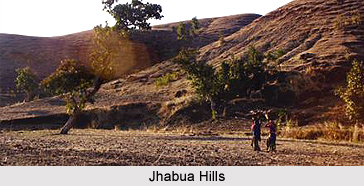 Geography of Jhabua district is rarely covered by forests because of its less fertile land. The district of Jhabua in the state of Madhya Pradesh is surrounded by the Panchamahal district and Vadodara district of Gujarat, Banswara district of Rajasthan and Dhar district and Ratlam district of Madhya Pradesh. Narmada River forms the southern boundary of the Jhabua district. The terrain is hilly, undulating typically known as `Jhabua hills topography`. In this Jhabua hill topography the difference between the highest and the lowest points varies between 20 meters to 50 meters. But this difference goes on increasing as one moves towards south of Jhabua district. In Alirajpur division, which is in the south of the district of Jhabua, the areas is almost entire hilly and intersected by narrow valleys and low Vindhayan ranges covered with jungles. But a major portion of the district of Jhabua is without any forest cover because of low fertility of land and soil erosion.
Geography of Jhabua district is rarely covered by forests because of its less fertile land. The district of Jhabua in the state of Madhya Pradesh is surrounded by the Panchamahal district and Vadodara district of Gujarat, Banswara district of Rajasthan and Dhar district and Ratlam district of Madhya Pradesh. Narmada River forms the southern boundary of the Jhabua district. The terrain is hilly, undulating typically known as `Jhabua hills topography`. In this Jhabua hill topography the difference between the highest and the lowest points varies between 20 meters to 50 meters. But this difference goes on increasing as one moves towards south of Jhabua district. In Alirajpur division, which is in the south of the district of Jhabua, the areas is almost entire hilly and intersected by narrow valleys and low Vindhayan ranges covered with jungles. But a major portion of the district of Jhabua is without any forest cover because of low fertility of land and soil erosion.
The total geographical area over which the district of Jhabua is spread is 6793 square kilometers. The total area of this district covered by forest is 645 square kilometers. The Jhabua district is devoid of vegetation cover except Katthiwada and other patches and is full of undulated, hilly areas. The area of this district suffers from poor and skeletal soils with shallow to very shallow depth and erratic rainfall, high temperature, etc. The area comes under Agro-climatic zone number twelve, namely Jhabua hills covering an area which is 1.5 percent of the total geographical area of Madhya Pradesh. The district has three distinct sub zones which are Petlawad (Malwa), Katthiwada (High rainfall) and Jhabua (Low rainfall) zones.
The district of Jhabua in Madhya Pradesh state enjoys a moderate climate and seasons here are well defined. The summers are usually hot, winters are short and the monsoon season is generally pleasant. The average rainfall received by this district is about 800 millimetres. Most of the rainfall occurs during the monsoon season while there is also little rainfall in winter season. The Narmada River is the largest river of the Jhabua district. It flows from east to west along the southern boundary. Some of the other rivers flowing in this district include the Hatni River, Mahi River, Anas River, etc.






